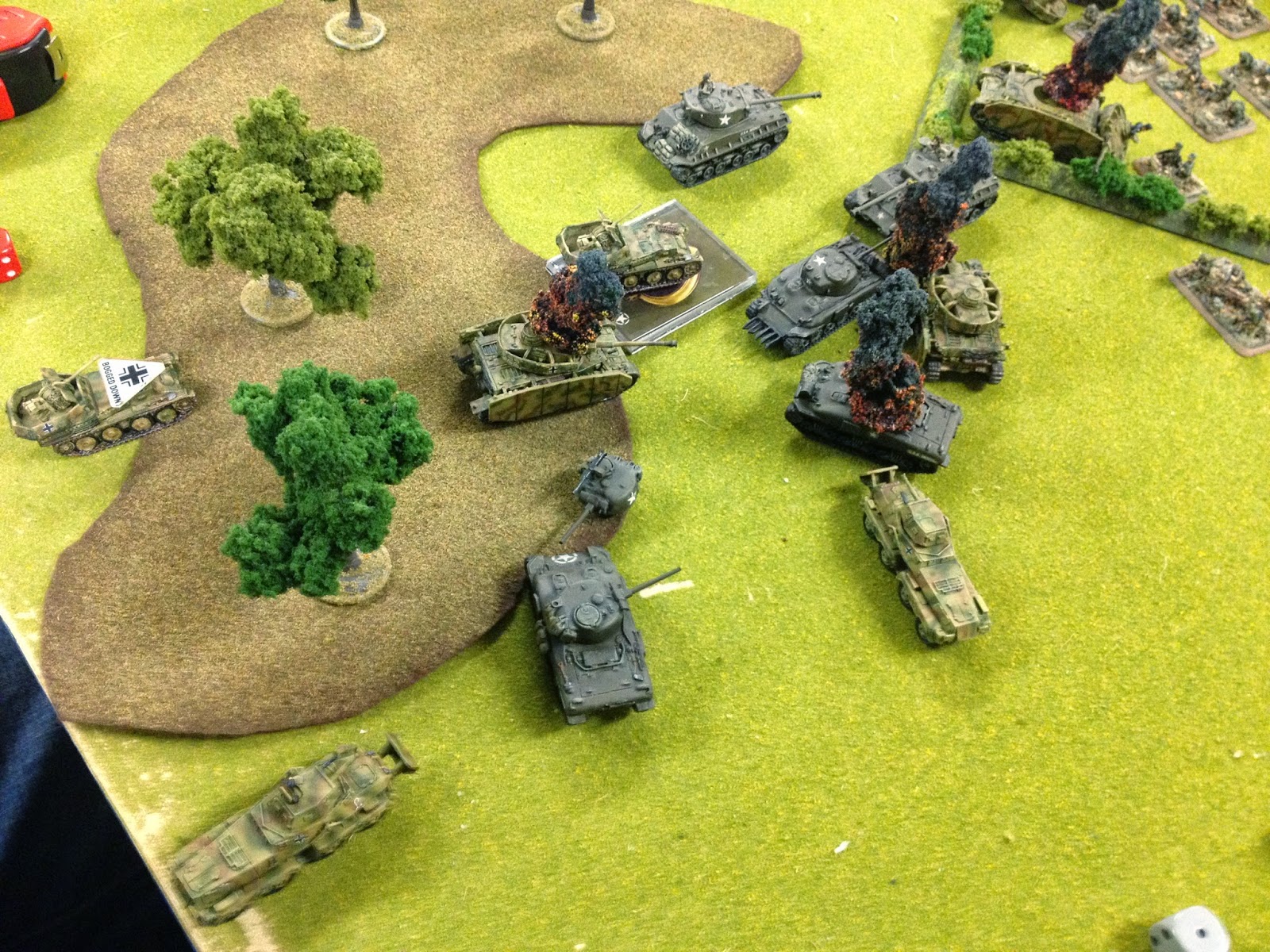| Mechanised Ace Rupert Gile's exploits in Operation Sealion made him a legend in my household. |
I can't extol their virtues enough.They are the true workhorse in any of my mobile forces lists and no turn finds them still: Eyes and Ears to make enemy infantry vulnernable and then mowing them down with tons of machine gun fire, racing for objectives, hunting armoured cars or flanking light tanks with their powerful main gun, distracting the enemy when necessary and disengaging for survivability, and using Cautious Movement to seek out concealed areas to make them a tougher target to hit.
FACT SHEET
- Name: Staghound T17 Armoured car
- Type: Reconnaissance armoured vehicle
- Armament: M3 75mm gun, Co-ax MG, Hull MG
- Maneuverability: Wheeled
- Armour: Minimal 3/1/0
- Max Speed: 18”
- Favoured Terrain: Roads, Cross Country
- Nationalities: England, and Commonwealth forces.
TACTICAL IMPLICATIONS
A striking symbol of British reconnaissance, the Staghound’s armament and recce capabilities make it one of the most versatile tools in my army. The Staghound is one of my premier attack vehicles. I play typically Confidant Veterans and use Staghounds as a vanguard of my main strike force to reduce primary defenses, distract the bulk of the enemy's firepower, or threaten objectives. With a 4 up to hit, keeping my staghounds in concealed terrain and at long range increases their survivability, giving them a 5 up to hit when concealed and a 6 up to hit at long range. In addition, if they are surprised by something they cannot take on, such as a front facing tank, they can disengage instead of firing. It' s not unheard of for my Staghounds to survive the entire length of a battle and ride off safely into the sunset.Versus Infantry
Staghounds are able to bring a lot of machine gun fire to bear on infantry in the open. A typical platoon of three Staghounds brings 12 machine gun shots to the party, has enough armour to survive infantry machine gun fire, and is not pinned down by suppressive fire, using Eyes and Ears first to make enemy infantry more vulnerable if necessary.| Scrapping some German half-tracks and then speeding off into the sunset. |
Versus Vehicles
The 75mm main gun is capable of taking out armoured cars and some types of tanks head on, but it really excels in sneaky flanking maneuvers. The fully mobile turret ensures that the Staghound is covered by 360° armament, reducing enemy flanking abilities. Even Germans with their big cats have to think twice before advancing when Staghounds are on the prowl. A flanked panther can be destroyed on a roll of 1 and bailed on a roll of 2 by the Staghound's main gun.| Staghounds fearlessly roll up on a couple of Panzer IIIs, planning to veer off to flank the tanks. |
Assaults
Taking Objectives
Using the advantage of speed and cover, I can generally get to an objective rather early in a game. This is helpful for two different strategies a) holding the objective with a type of guerrilla warfare by disengaging and harassing any competition b) creating a sense of urgency with the enemy who will scramble to react while I direct another force to a different enemy objective. You can also use the versatility of a staghound to rather safely contest an objective.
| Did I mention my staghounds also bring their own luck? |
The main weakness is the light armour, especially if the vehicle cannot disengage. The armour won’t stand up to most enemy tank fire, and it worthless against air support. I try to keep Staghounds close to forests and buildings to force the enemy to roll to range in.
Being wheeled is also a weakness. When encountering slow going terrain, having to drop down to 4 inch movement can be brutal. Many other recce vehicles are jeeps that can move much quicker. So the Staghound trades some speed to get heavier armour. They can use disengage and start of game recce moves to compensate some for the speed deficit.
The worst use of the Staghound is as the vanguard of a frontal assault mission against a fortified enemy position in a flat setting. Staghounds have limited to no value in defensive or garrison assignments as their major advantages can be reproduced with heavy tank fire in a more economical way.
Although these weaknesses are something to be mindful of, they are relatively small faults in my mind as I love the cost to versatility ratio.
| Giles calls in his bagpiper to celebrate his There Can Be Only One triumph over the German Commanding Officer. |
TERRAIN APPLICATIONS
A column of Staghounds also work in urban environments since they they are highly maneuverable, they can use eyes and ears against entrenched enemies, and there is plenty of cover. They also present a small, compact target to the enemy and pack enough high explosives to take out infantry within the buildings.
| Staghounds supporting an infantry team breaching emplacements before storming the objective at the top of the hill. |
Conclusion
Despite its strengths, the Staghound’s armour is a physical limitation that make it a challenging weapon to use in certain situations. To countermand this, disengaging is a particularly helpful tool for saving these fragile vehicles and removing them from constricted situations where an enemy contingent could potentially ambush my typically unaccompanied Staghound platoon. Given the small cost associated with Staghounds, it’s easy to realize maximum value from their weapons and their CYA recce moves limit the risk of major losses. I have actually used my Staghounds as a a psychological weapon against infantry with a sheer machine gun power pinning and breaking an enemy infantry column.In areas where fortifications are not present, Staghounds can provide a mobile punch that can be used to harass enemy advances and objectives, but this is very much dependent on the circumstance and do not reflect the main role of the vehicle.













































